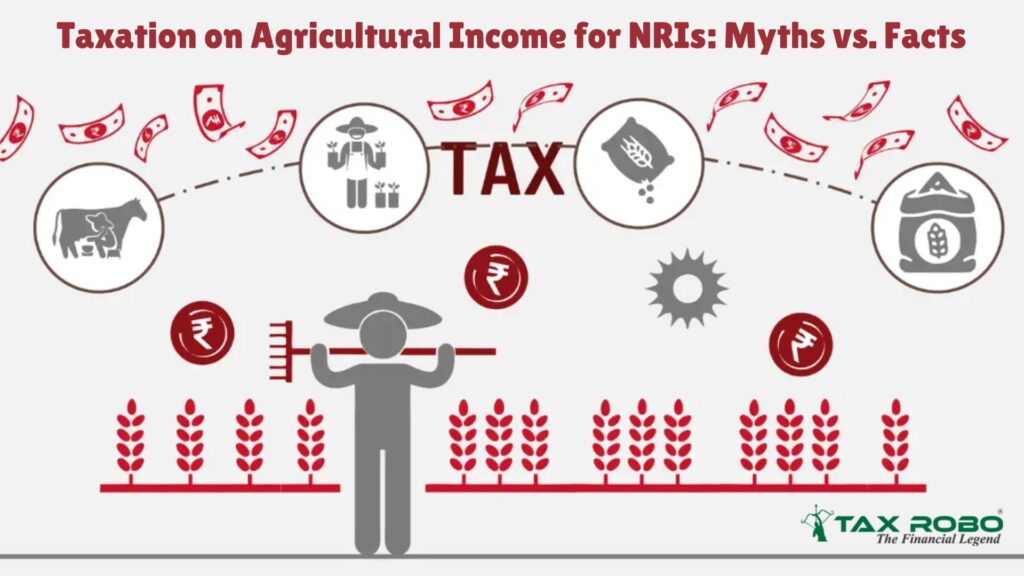Agricultural Income
Taxation laws often generate confusion, particularly when it comes to non-resident Indians (NRIs) earning agricultural income in India. Misconceptions abound, making it crucial to distinguish between myths and facts. This blog explores the nuances of taxation on agricultural income for NRIs to provide clarity on the subject.
Meaning of Agricultural Income
The Income-tax Act has its own definition of agricultural income which constitutes the following 3 main activities:
I. Rent or revenue earned from agricultural land situated in India:
Rent is the amount received to grant the right to use the land. There are many possible sources of income that can be derived from land. An example would be fees received for renewal of grant of land on lease.
However, the amount received on the sale of land is not covered under the definition of agricultural income.
II.Income from agricultural land in the following ways:
Agriculture: The meaning of agriculture though not covered in the Act, has been laid down by the Supreme Court in the case CIT v. Raja Benoy Kumar Sahas Roy where agriculture has been explained to consist of two types of operations –basic operations and subsequent operations.
The basic operations would include cultivation of the land and consequently tilling of the land, sowing of seeds, planting and all such operations that require human skill and effort directly on the land itself.
The subsequent operations would include operations that are carried out for growth and preservation of the produce like weeding, digging soil around the crops grown etc and also those operations which would make the product fit for use in the market like tending, pruning, cutting, harvesting, etc. Income derived from saplings or seedlings grown in a nursery would also be considered to be agricultural income whether or not the basic operations were carried out on land.
Through the performance of a process by the cultivator or the receiver of rent (in-kind) that results in the agricultural produce being fit to be taken to the market: Such processes involve manual or mechanical operations that are ordinarily employed to make the agricultural produce fit for the market and the original character of such produce is retained.
Through the sale of such agricultural produce: Where the produce does not undergo ordinary processes employed to become marketable, the income arising on sale would generally be partly agricultural (exempt) income and part of it will be non-agricultural (taxable) income.
The Income Tax has prescribed rules to make this bifurcation regarding agricultural and non-agricultural produce for products like tea, coffee, rubber, etc.
| Operation | Agricultural Income | Non-Agricultural Income |
| Growing and Manufacturing Tea | 60% | 40% |
| Manufacturing Rubber | 65% | 35% |
| Growing and curing Coffee | 75% | 25% |
| Coffee grown, cured, roasted, and grounded with or without mixing chicory or other flavouring ingredients | 60% | 40% |
III. Income derived from farm building required for agricultural operations:
- The conditions for classifying income derived from farm building as agricultural income are as follows:
- The building should be on or in the surrounding area of the agricultural land. Also, the rent receiver or cultivator of the land, by reason of his connection with the land, requires the building as a house to stay or as a storehouse or uses it for these kinds of situations
- Either of the two conditions should be satisfied:
- The land is assessed by either land revenue or a local rate assessed and collected by government officers; OR
- If the above condition is not satisfied, the land should not be located within the following region:
| Aerial distance from municipality* | Population as per last preceding census. |
| Within 2 kms | 10,000 to 1,00,000 |
| Within 6 kms | 1,00,000 to 10,00,000 |
| Within 8 kms | >Rs. 10,00,000 |
Examples of Agricultural Income
The following are some the examples of agricultural income:
- Income from the sale of seeds.
- Income from the sale of replanted trees.
- Interest on capital received by a partner from a firm engaged in agricultural operations.
- Income from growing flowers and creepers.
- Rent received for agricultural land.
- Profits received by a partner from a firm involved in agrarian produce or activities.
- Income from growing of bamboo.
Examples of Non-Agricultural Income
Below are some examples of non-agricultural income:
- Income from poultry farming.
- Income from agricultural land held as stock-in-trade
- Any dividend paid from an organization’s agriculture income.
- Income from dairy farming.
- Income from bee hiving.
- Income from fisheries.
- Income from cutting and selling timber trees.
- Income from butter and cheese making.
- Receipts from TV serial shooting in the farmhouse.
Agricultural Income in Income Tax: Exemption Limit, Tax Calculation, Examples
Myth 1: Agricultural Income is Entirely Tax-Free in India
Fact: While agricultural income enjoys a tax exemption under Section 10(1) of the Income Tax Act, this exemption comes with conditions. For NRIs, agricultural income is exempt from tax if it is earned directly from agricultural activities, such as cultivating land, harvesting crops, or similar operations. However, if the agricultural income is combined with non-agricultural income (like business income), the total income might be subject to partial taxation under the “aggregation method.”
Myth 2: NRIs Cannot Claim Tax Exemptions on Agricultural Income
Fact: NRIs are eligible for tax exemptions on agricultural income, just like resident Indians. The key lies in demonstrating that the income arises from genuine agricultural activities. Proper documentation, such as land ownership records, proof of cultivation, and sales receipts, is essential to substantiate the claim for exemption.
Myth 3: Income from Farmhouses or Plantations is Automatically Tax-Free
Fact: Not all income related to farmhouses or plantations qualifies as agricultural income. For example, income from renting a farmhouse or using it for non-agricultural purposes, such as commercial activities, is taxable. Similarly, income from plantation crops like tea, coffee, or rubber is partially taxed under a specific formula prescribed by the Income Tax Act.
Myth 4: No Need to Report Agricultural Income
Fact: Even if agricultural income is tax-exempt, it must still be reported when filing income tax returns in India. Failing to declare this income could lead to scrutiny by tax authorities, especially for NRIs with significant financial interests in India.
Myth 5: Double Taxation on Agricultural Income for NRIs
Fact: India’s Double Taxation Avoidance Agreements (DTAAs) with various countries often mitigate the risk of double taxation. If agricultural income is taxed in the country of residence, the DTAA provisions may allow for tax relief in India. It is advisable for NRIs to consult tax professionals familiar with both jurisdictions to maximize the benefits of DTAAs.
Myth 6: Agricultural Income is Always Excluded from the Tax Slab
Fact: While agricultural income itself may be exempt, it can indirectly affect tax liability through the aggregation method. This method adds agricultural income to other taxable income to determine the applicable tax slab, potentially increasing the tax rate on the non-agricultural portion.
Tips for NRIs to Navigate Agricultural Income Taxation
- Maintain Comprehensive Records: Proper documentation is critical for claiming exemptions.
- Understand the Aggregation Method: Familiarize yourself with how this method impacts your overall tax liability.
- Consult Tax Experts: Seek advice from professionals experienced in Indian tax laws and international taxation.
- Stay Updated: Tax laws evolve, and staying informed helps avoid legal and financial complications.
In conclusion, understanding the facts about taxation on agricultural income can help NRIs avoid common pitfalls and make informed financial decisions. By debunking these myths, NRIs can better navigate the complexities of Indian taxation and ensure compliance with the law.



